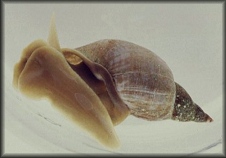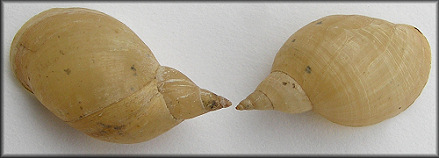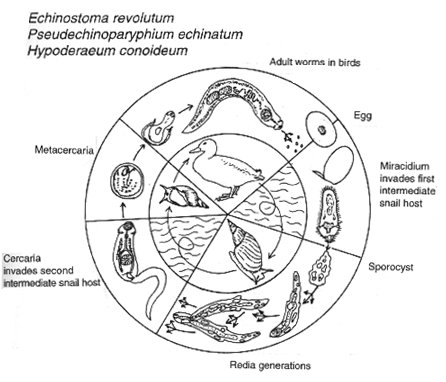| - Part One - | |
| Mollusks And Man: A Medical Perspective | |
| By Harry G. Lee, M.D. | |
|
As shell-fanciers, most of us are keenly aware of the prominent role of mollusks in the history of humankind. On balance, our species has benefited from the interaction recreationally, aesthetically, gustatorily, and so forth. Yet there is another facet in this inter-phyletic relationship. Since I spend much of my non-shelling time ministering to the sick (and those who don't want to be), your editors have asked me to bring to their readers some special unpleasantness in the form of a discussion of how mollusks affect human health. Three topics seem to sort themselves out for discussion: infection, poisoning, and envenomation. We shall proceed in that order. This present issue will deal with infectious diseases, mollusks, and man. |
|
|
|
|
|
Lymnaea stagnalis (Stagnant Pond Snail) |
|
| On a global scale, the
most significant infections involving mollusks are caused by a
group of flatworms (Trematodes) called flukes. These parasites
apparently have a long evolutionary relationship with mollusks.
Originally confining their parasitism to mollusks, some fluke
species evolved into what we call a digenetic mode, having two
generations, an asexual cycle in the invertebrate, typically a
freshwater snail, and a sexual one in a vertebrate host. Larval
states, first the cercaria, which emerges from the snail and
actively or passively infects the vertebrate, and the miracidium,
which leaves the egg excreted by the vertebrate and infects the
snail, provide essential links in the digenetic fluke life cycle.
(See figure following article) The most important human fluke infection is Schistosomiasis (also called Bilharzia or Bilharziasis). Four important species of Schistosoma: haematobium, mansoni, mekongi and japonicum account for hundreds of millions of cases, mainly in Egypt, sub-Saharan Africa, tropical Asia, the Middle Fast and portions of the tropical New World. The adult worms are less than an inch in length and live in the small blood vessels of abdominal and pelvic viscera where major damage to the liver, urinary tract and intestine can ensue. Disease transmission occurs in cercaria-infested waters that allow selective snail hosts, Biomphalaria, Bulinus, Tricula (etc.), and Oncomelania respectively, to prosper. Control of schistosomiasis is largely a matter of improving sanitation, since human excreta bearing parasite eggs must be excluded from waters which harbor host snails and which contact human skin. Local customs and global economies make such intervention more easily said than done. Treatment of human infections has become more tolerable and effective over the last half century, but is not yet widespread. Other schistosomes may infect livestock and numerous wild animals, including birds. Swimmer's Itch is a form of dermatitis caused by cercariae entering human skin (where they perish after provoking an inflammatory response) instead of aquatic birds, wherein they normally grow to adulthood. You can get Swimmers's Itch in the Great Lakes, Lake Okeechobee, and the brackish waters of west Florida. There are several other human infections caused by flukes - liver, lung, and intestinal, for instance. An important liver fluke infection of our livestock is caused by Fasciola hepatica and is transmitted via Lymnea snails in pastureland. The consumption of raw bivalves is a hot and touchy subject these days. A "new" human disease, infection with Vibrio species, most notably V. vulnificus has received ample attention in the 1990's media. This bacterium, V. vulnificus, unlike its congeners, is capable of invading human tissue and cause serious disease, not infrequently death. Individuals who have impaired immunity and/or liver disease are at far greater risk of fatal outcomes, but otherwise healthy persons have died from this infection. The germ is naturally free-living and often abundant in marine and estuarine waters, where it is occasionally concentrated in the tissues of filter-feeding bivalves. The germ is killed by conventional cooking techniques, but consumption of raw bivalve flesh, especially that of Crassostrea virginica, can cause gastrointestinal infection, and, in severe cases, bloodstream invasion and septicemia. Processing methods such as exposure of shellfish meats to ultra-violet radiation or depuration (natural cleansing of living bivalves with bacteria-free seawater) are effective but not yet economically feasible. Abstinence or careful cooking (not just to the point of initial gaping of valves) appear to be the only practical safeguards available to culinary consumers. Treatment is available, but some cases are so fulminant that even prompt institution of antibiotics may be too late. Infectious Hepatitis (or Hepatitis A) is an exclusively human disease caused by a virus transmitted through the digestive tract. When suspended in water, the viruses are concentrated in filter feeding bivalve tissue like the Vibrio species. Often raw shellfish consumption (more aptly oysters, clams, mussels, not crustaceans) has been incriminated in outbreaks of Infectious Hepatitis. Because of the association of fecal contamination of bivalve habitat with the threat of hepatitis, bacteriological surveillance by public health people allows the quarantining of potentially infectious harvests. It is important to note that the traditional policing of bivalve beds does not protect against Vibrio vulnificus contamination since the germ is not associated with coliforms. While there is no treatment for Hepatitis A, the release of a vaccine is imminent. Thorough cooking kills the virus. Most cases are mild, but the illness is not uncommon and produces a fair degree of morbid symptoms in many cases. There are several other infections - bacterial dysenteries, soft tissue Vibrio infections - even round worm meningo-encephalitis, which involve mollusks, but the flukes (snails) and enteric infections (bivalves) discussed above are principal. Behavioral modification is all it takes to avoid these unpleasant encounters. However, decisions like eschewing raw oysters are particularly difficult for devout aficionados, of which I, too, am one. |
|
|
|
|
| *Adapted from The Junonia, newsletter of The Sanibel-Captiva Shell Club, June 1995 and published in the Shell-O-Gram, July-August, 1995. | |
|
|
|


